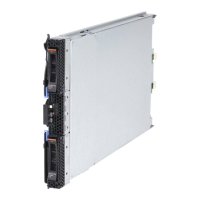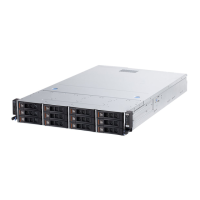Chapter 4. Configuring the blade server
There are several components on the blade server that you can configure and
several methods for configuring those components.
Note: If you intend to use a scalable blade complex in single partition mode, you
must partition the complex before you turn on the blade servers or begin the
configuration process. See “Partitioning a scalable blade complex” on page 72 for
information.
Typically, you complete the following steps to configure the blade server:
1. Configure the Unified Extensible Firmware Interface (UEFI) firmware for the
blade server. You can configure the UEFI firmware by using the Setup utility or
the Advanced Settings Utility (ASU). For more information about the Setup
utility, see “Using the Setup utility” on page 72. For more information about
ASU, see “Using the Advanced Settings Utility (ASU)” on page 77.
Note: For more information about firmware configuration options, see
Introducing UEFI-Compliant Firmware on IBM System x and BladeCenter Servers at
http://www.ibm.com/systems/support/supportsite.wss/
docdisplay?lndocid=MIGR-5083207&brandind=5000008.
2. Set the boot protocol. To set the boot protocol, use either the Setup Utility or
the Preboot Execution Environment (PXE) boot agent utility program. For more
information about the PXE boot agent utility program, see “Using the PXE boot
agent utility program” on page 76.
Note: You can temporarily redefine the boot order by using the Boot menu
program that is provided with the blade server firmware
3. Configure the RAID array.
You can install up to two solid state drives in the blade server and implement
RAID level-0 (striping) or RAID level-1 (mirror) arrays in operating systems
that are listed on the ServerProven list at http://www.ibm.com/servers/
eserver/serverproven/compat/us/eserver.html. For the blade server, you must
configure the RAID by using the LSI Configuration Utility program.
Note: If you are implementing a scalable blade complex in single partition
mode, you cannot combine the SSD in both the primary and the secondary
server to define a RAID array. RAID arrays can be defined using only the SSDs
within a blade server.
If an optional RAID expansion card is installed, you can use it to control all the
storage drives that are installed in the blade server. See the documentation that
comes with the expansion card for information about how to configure the
RAID array.
Important: You must create the RAID array before you install the operating
system on the blade server.
4. Configure the integrated management module (IMM). To configure the IMM,
use either the Setup utility or the Advanced Settings Utility (ASU).
5. Update the blade server firmware. For more information about updating blade
server firmware, see “Updating firmware and device drivers” on page 82 If you
are performing inband updates to firmware on blade servers operating as a
single partition in a scalable blade complex, see “Updating firmware for blade
© Copyright IBM Corp. 2011 71

